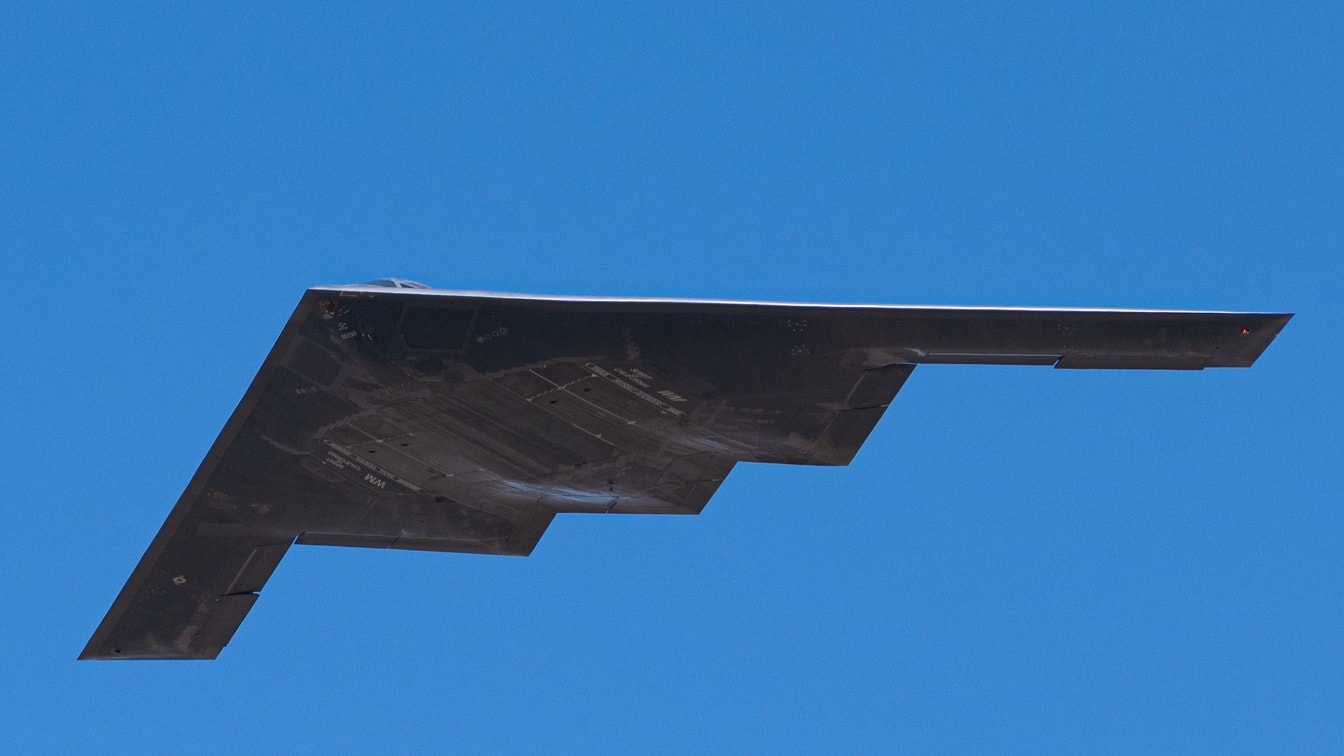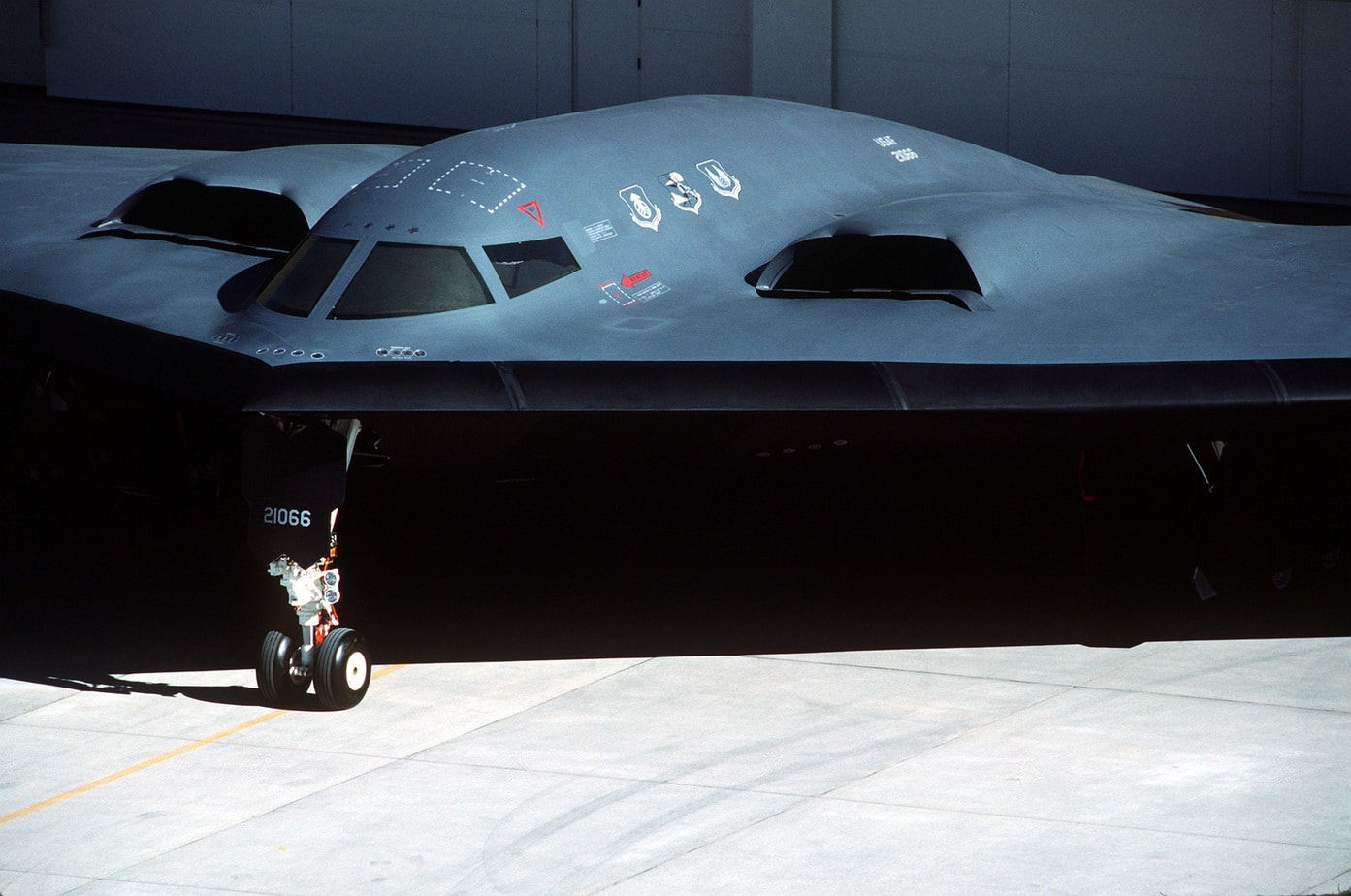The US Air Force B-2 Spirit stealth bomber is a heavy strategic bomber with low-observable stealth technology designed to penetrate dense anti-aircraft defenses. Designed by Northrop Grumman, it has a subsonic flying wing and a crew of two. It was produced from 1987 to 2000.
The bomber can drop conventional and thermonuclear weapons, such as up to eighty 500-pound class (230 kg) Mk 82 JDAM GPS-guided bombs or sixteen 2,400-pound (1,100 kg) B83 nuclear bombs. The B-2 is the only acknowledged in-service aircraft that can carry large air-to-surface standoff weapons in a stealth configuration.
Why The Air Force Wanted 75 B-2s
During the height of the Cold War, the US was looking for a stealth bomber, one that could fly into the Soviet Union undetected by radar and drop nuclear weapons on the Soviet war machine and infrastructure in the event of war.
At the time, no one had stealth aircraft except the United States, which had two: the F-117 Nighthawk and the B-2 Spirit.
The B-2 Spirit’s testing was so successful that some Pentagon and Air Force members wanted 165 of the then-named Advanced Technology Bomber (ATB) bombers.
The Air Force procured 132 in the 1980s, but that number was reduced to 75. The design changed because the mission changed from high to low altitude. But then, the boogie man went away.
Once the Soviet Union collapsed in the early 1990s, the Cold War mission and the dreaded Soviet Union were no more.
Under pressure from Congress, President George H.W. Bush announced in his 1992 State of the Union address that production for the B-2 would stop at just 20 aircraft.
This number was after his Defense Secretary Dick Cheney convinced Bush that there was no longer the need for that many nuclear bombers. It was a short-sighted mistake. America did need those B-2 bombers. Russia under Putin rearmed and began to act aggressively again.
China turned its military around quickly and decided that most of the South China Sea was its territory. North Korea and Iran (again) made the world a much more dangerous place.
Under Bill Clinton, the number of B-2s would increase to 21. He authorized the conversion of a twenty-first bomber, a prototype test model, to fully operational Block 30 status at a cost of nearly $500 million.
The reason for the cutbacks was the cost. The B-2, the Government Accountability Office (GAO) said in 1996, “will be, by far, the costliest bombers to operate on a per aircraft basis,” costing over three times as much as the B-1B (US$9.6 million annually) and over four times as much as the B-52H (US$6.8 million annually).
In September 1997, each hour of B-2 flight necessitated 119 hours of maintenance. Comparable maintenance needs for the B-52 and the B-1B are 53 and 60 hours, respectively. The total cost to the US taxpayer for each aircraft, complete with maintenance facilities, is a whopping $2 billion.
Meet The B-2 Spirit
The Spirit is a flying wing design with no fuselage or tail. It can carry 40,000 pounds of munitions inside two internal weapons bays. Originally, 16 JDAMs (Joint Direct Attack Munitions) could be dropped. These highly accurate “smart bombs” can punish the enemy into submission.
Then, the Air Force figured out a way to improve the hard point design in the bomb bays, and now up to 80 JDAMs can be carried.
The B-2’s flying wing design and radar-absorbing materials were intended to dramatically reduce the aircraft’s radar cross-section compared to conventional bombers and make it exceedingly difficult to detect and track
Four General Electric F118-GE-100 non-afterburning turbofans power the B-2, each producing 19,000 pounds of thrust. Its maximum speed is 630 mph at 40,000 feet altitude / Mach 0.95 (729 mph) at sea level. The cruise speed is 560 mph at 40,000 feet altitude. The range is 6,900 miles without inflight refueling.
Today, there are only 19 B-2s left. One crashed in 2008, and another accident in 2022 damaged the aircraft so much that it was decided not to be repaired.
Outstanding Combat Record
The B-2’s combat record has been off the charts during recent conflict usage. It made its first combat mission in Kosovo in 1999. In the first eight weeks of US involvement in the war, the B-2 destroyed 33 percent of selected Serbian bombing targets. Spirits were used in Afghanistan, and some missions were flown from Whiteman AFB in Missouri to Afghanistan and back.
In the 2003 invasion of Iraq, the B-2 shined during the Shock and Awe campaign. B-2s destroyed an ISIS training camp in Libya. On October 24, 2024, B-2s carried out strikes on weapons storage facilities in Yemen, including underground facilities owned by the Houthis.
Five hardened underground weapons storage locations were struck as part of the campaign against the Iranian proxy Houthis for attacking international shipping in the Red Sea. It was believed the strikes also served as a warning to Iran, demonstrating the stealth bomber’s ability to destroy targets buried underground.

A B-2 Spirit stealth bomber from Whiteman Air Force Base completes a fly-over during the Sound of Speed Airshow at Rosecrans Air National Guard Base, in St. Joseph, Missouri, May 1, 2021. The air show was hosted by the city of St. Joseph and 139th Airlift Wing, Missouri Air National Guard to thank the community for their support. (U.S. Air National Guard photo by Airman Janae Masoner)
The Air Force said the B-2 Spirit could threaten an adversary’s “most valued, and heavily defended, targets. Its capability to penetrate air defenses and threaten effective retaliation provides a strong, effective deterrent and combat force well into the 21st century.”
For Now, The B-2 Stands Alone
The development of the B-21 Raider echoes a Cold War II scenario. Like the B-2, the B-21 is a flying wing-type strategic stealth bomber. However, its stealth capabilities are considered significantly more advanced than those of the B-2, thanks to modern materials and improved avionics and other flight systems.
“The US Air Force has stated plans to acquire at least 100 aircraft. Some defense analysts believe that the Air Force should plan to purchase at least 200 B-21s,” according to Northrup Grumman.
Although the B-21 Raider is the future, the B-2 is still very much the present. It is the tip of the spear for American penetration bombing missions against its enemies.
About the Author: Steve Balestrieri
Steve Balestrieri is a 19FortyFive National Security Columnist. He served as a US Army Special Forces NCO and Warrant Officer. In addition to writing for 19FortyFive, he covers the NFL for PatsFans.com and is a member of the Pro Football Writers of America (PFWA). His work was regularly featured in many military publications.

